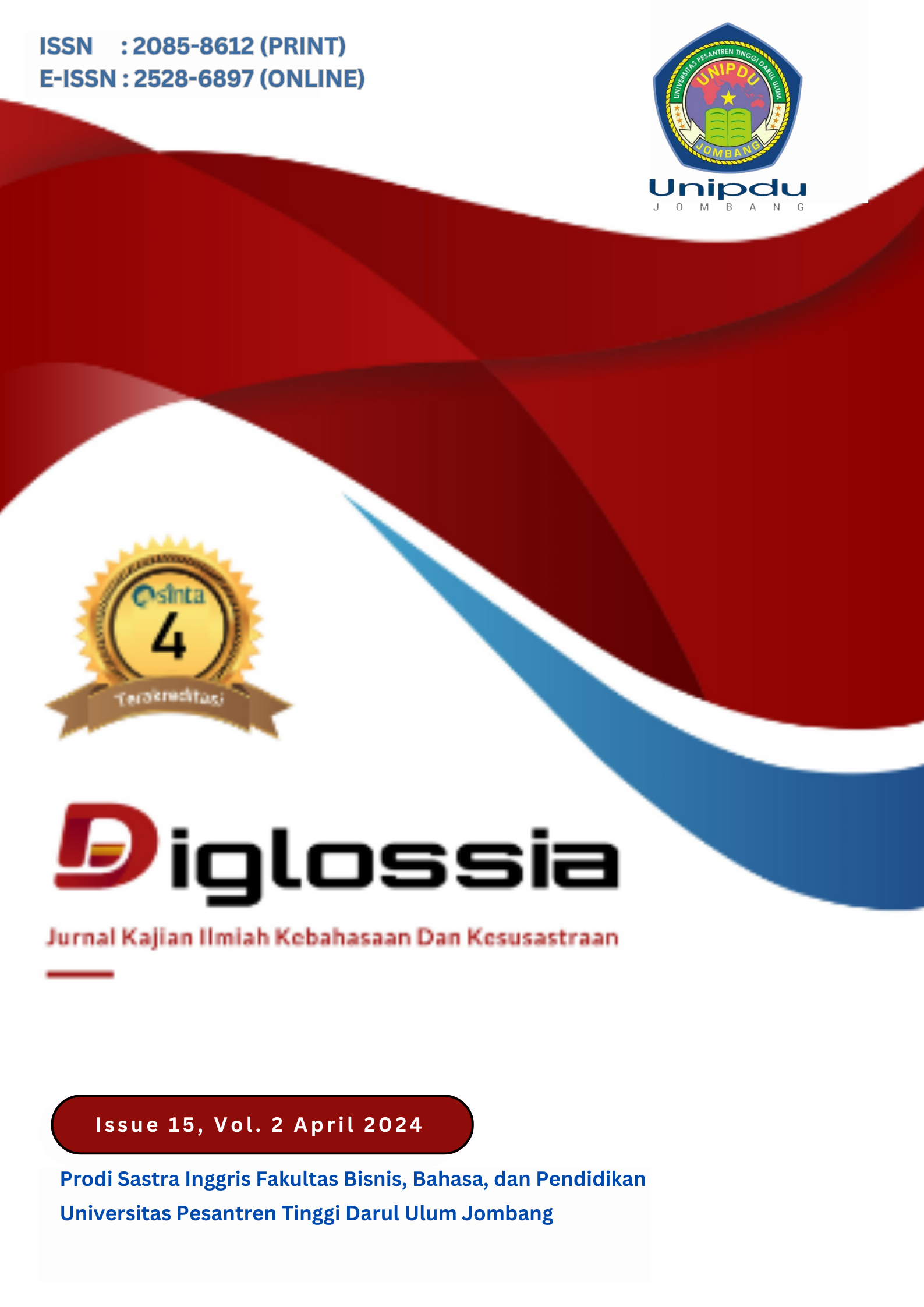Tindak Tutur yang Muncul dari Hasil Respons Mitra Tutur Terhadap Tuturan Komisif
DOI:
https://doi.org/10.26594/diglossia.v15i2.4495Keywords:
direktif, ekspresif, komisif , representatif , tindak tuturAbstract
Berfokus pada tindak tutur ilokusi, tindak tutur jenis ini memiliki lima jenis, yaitu tindak tutur representatif (asertif), komisif, direktif, ekspresif, dan deklaratif. Sehubungan dengan hal tersebut, penelitian ini membahas tentang tindak tutur yang muncul dari hasil respons mitra tutur terhadap tuturan komisif dalam anime Nisekoi karya Naoshi Komi. Tujuan penelitian ini adalah untuk mendeskripsikan jenis tindak tutur apa yang muncul dari hasil respons mitra tutur dalam anime tersebut. Penelitian ini menggunakan teori jenis tindak tutur oleh Searle (1979: 12-17). Metode yang digunakan adalah metode deskriptif kualitatif. Hasil penelitian ini ditemukan sebanyak 53 data jenis tindak tutur yang muncul dari hasil respons, yaitu terdiri dari 1) tindak tutur representatif muncul sebanyak 7 data; 2) tindak tutur komisif sebanyak 10 data; 3) tindak tutur direktif sebanyak 24 data; dan 4) tindak tutur ekpresif sebanyak 12 data. Dari total temuan data, jenis tindak tutur direktif paling banyak ditemukan daripada jenis tindak tutur lainnya, kemudian, tidak ditemukan adanya respons yang tergolong jenis tindak tutur deklaratif.
References
Andini, Wike Yesa. (2022). TINDAK TUTUR KOMISIF DALAM ANIME HOTARU NO HAKA KARYA ISAO TAKAHATA. Fakultas Bahasa dan Seni. Universitas Negeri Padang. Padang.
Austin, J. L. (1962). How to Do Things with Words. London: Oxford University Press.
Koizumi, T. (2013). Nyuumon Goyouron Kenkyuu Riron to Ouyou. Tokyo: Kenkyuusha.
Kridalaksana, H. (2011). Kamus Linguistik. Jakarta: PT. Gramedia Pustaka Utama.
Leech, G. (1993). Prinsip-prinsip Pragmatik (diterjemahkan oleh Oka). Jakarta: Universitas Indonesia Press.
Prasetiyo, N.A.P. (2021). ILOKUSI TINDAK TUTUR KOMISIF DALAM PERCAKAPAN GURU DAN SISWA DALAM FILM ANSATSU KYOUSHITSU LIVE ACTION KARYA YUSEI MATSUI. Surabaya: Fakultas Sastra, Universitas Dr Soetomo.
Rusminto, N. E. (2009). ANALISIS WACANA BAHASA INDONESIA (BUKU AJAR). Bandar Lampung: Universitas Lampung.
Searle, J. R. (1979). Expression And Meaning: Studies in the Theory of Speech Acts. Cambridge: Cambridge University Press.
Sudaryanto. (2015). Metode dan Aneka Teknik Analisis Bahasa. Yogyakarta: Sanata Dharma University Press.
Sugiyono. (2013). Metode Penelitian Kuantitatif, Kualitatif dan R&D. Bandung: Alfabeta. CV.
Tilana, Nadea Fatmala. (2018). SKALA KESANTUNAN TINDAK TUTUR KOMISIF DALAM ANIME FUNE WO AMU EPISODE 1-3. Semarang: Fakultas Ilmu Budaya. Universitas Diponegoro.
Wibawa, Gede Pandu. (2017). TINDAK TUTUR KOMISIF DALAM FILM GREAT TEACHER ONIZUKA SPECIAL GRADUATION. Semarang: Fakultas Ilmu Budaya, Universitas Diponergoro.
Yule, George; Jumadi; Kartika N. Nugrahini. (2017). Pragmatik. Yogyakarta : Penerbit Ombak.
Downloads
Views: 254 | Downloads: 188
Published
How to Cite
Issue
Section
License
Copyright (c) 2024 Diglossia: Jurnal Kajian Ilmiah Kebahasaan dan Kesusastraan

This work is licensed under a Creative Commons Attribution 4.0 International License.
- Authors who submit a manuscript to this journal and accepted for publication, copyright of the article shall be assigned to the authors of the article.
- Copyright encompasses exclusive rights to reproduce and deliver the article in all forms and media, including reprints, photographs, and any other similar reproductions, as well as translations. The reproduction of any part of this journal, its storage and transmission of databases by any forms or media, such as electronic, mechanical copies, photocopies, and recordings will be allowed by Diglossia
- Editorial Board of Diglossia tries to make every effort to ensure that no wrong or misleading data, opinions or statements be published in the journal. The contents of the articles published to Diglossia are sole and exclusive responsibility of their respective authors.
- The copyright form should be filled with respect to article and be signed originally and sent scanned document file (softcopy) and the article to our email, jurnal.diglossia@fbs.unipdu.ac.id or sent it to the Editorial Office in the form of original hard copy and the article in softcopy form on Flash Disc or Compact Disc, to;Diglossia: Jurnal Kajian Ilmiah Kebahasaan dan Kesusastraan
Prodi Sastra Inggris Fakultas Bisnis dan Bahasa
Universitas Pesantren Tinggi Darul Ulum
Kompleks Pondok Pesantren Darul Ulum
Rejoso Peterongan Jombang Jawa Timur 61481

